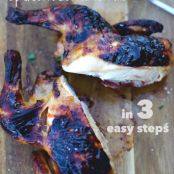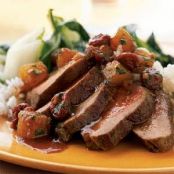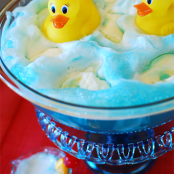Duck Confit - Preserved Duck
By á-174942
Ingredients
- 2 ducks - (abt 4 1/2 lbs ea) with necks, gizzards (or 4 pair duck legs with thighs attached)
- 3 tablespoons coarse (kosher) salt - (to 6)
- 1 1/2 tablespoons coarsely-chopped shallots
- 1 1/2 tablespoons chopped fresh parsley
- 2 teaspoons black peppercorns lightly crushed
- 1 bay leaf crumbled
- 1 teaspoon coarsely-chopped garlic
- 1 pinch dried thyme crumbled (or 1 sprig fresh thyme, chopped)
- 4 cups good quality lard or rendered goose fat - (to 6 cups) (not commercial, available at fancy butchers)
- 1 whole garlic head
- 2 whole cloves
- peanut oil
- 1/2 teaspoon salt - (to 3/4)
- Good quality lard
Details
Servings 1
Preparation
Step 1
1. 1 DAY IN ADVANCE: Trim loose flaps of skin from duck and pull out all loose fat from cavity; reserve. Remove any skin from necks; reserve. Peel off and discard outer covering of gizzards.
2. Using poultry shears or large, sharp, heavy knife, cut up ducks to produce pieces for confit: 4 legs (thigh with drumstick attached), 4 wings, and 4 breast pieces. Remove wing tips; reserve backs and wing tips for soup or other purpose. Remove skin from backs; add to reserved pieces of skin and fat.
3. Weigh the trimmed pieces. For every pound, use 4 1/3 teaspoons salt for longterm ripening (more than 1 week). Combine salt with shallots, parsley, peppercorns, bay leaf, minced garlic, and thyme in large bowl. Toss duck pieces, necks, and gizzards with the mixture. Cover with kitchen towel or plastic wrap and refrigerate 18 to 24 hours.
4. Meanwhile, cut reserved pieces of fat and skin into small pieces (1/4-inch or less) and render out most of the fat by either oven or stovetop method as follows: For oven method, heat oven to 300 degrees; cook duck fat and skin in deep ovenproof bowl for about 1 hour, or until fat turns clear and bits of skin have floated to the surface and are pale golden. Strain rendered fat into heatproof container. If not using fat immediately, cool, uncovered, to room temperature; store, tightly covered, in refrigerator.
5. THE FOLLOWING DAY: Place rendered duck fat in Slow cooker or large, very heavy pot such as enameled cast-iron casserole. Add 4 to 6 cups rendered poultry fat or lard exact amount will vary depending on size and shape of your cooking vessel. Slowly melt the fat.
6. Remove marinated duck pieces from bowl and rinse under cold running water. Let drain briefly (it is not necessary to dry surface completely).
7. As soon as fat has melted, slip in pieces of duck. Fat should cover duck; if there is not enough fat, work in batches. Split head of garlic in half crosswise and stick a whole clove in each half. Add garlic to melted fat.
8. In Slow cooker or over very low heat, uncovered, bring fat to temperature of 190 degrees; this should take about 1 hour in covered Slow cooker or partially covered casserole (faster heating will result in a stringy-textured confit). Hold temperature at 190, adjusting setting as necessary, until gizzards, neck, wings, and breasts are tender enough to be pierced easily with wooden pick, about 1 hour; Slow cooker should be partially covered. Skin will be pale in color. Remove these pieces with slotted spoon as they are done; keep pieces covered with foil to prevent drying out. Maintain 190 degree temperature another 30 minutes, or until thickest part of thigh tests done. Remove from heat, let duck legs cool in fat 1 hour. Remove duck thighs and garlic with slotted spoon.
9. Ladle fat to large, very heavy pot. Heat, uncovered, over medium-high heat to almost boiling, skimming off foam that rises to surface. Let bubble 5 to 10 minutes, or until spattering stops and surface of fat is nearly undisturbed. Watch carefully and adjust heat if necessary to avoid burning or smoking; fat that is allowed to reach smoking point will be ruined for reuse. Remove from heat; let cool a few minutes.
10. Have ready a clean, dry container or several containers chosen according to how long you plan to keep the confit.
11. Confit to be kept longer than a week and up to 4 months requires a somewhat different procedure. For this amount, use three 1-quart or two 1 1/2-quart crocks or jars. (Since pieces will be embedded in solidified fat and cannot be casually removed, it is necessary to use more than 1 vessel in order to separate larger pieces that will be served whole, or in attractive slices, from smaller and bonier ones that are best added to soups or stews.) Heavy, glazed earthenware crocks, taller than they are wide, are excellent. Remember that the narrower the vessel, the less fat will be needed to cover duck pieces; however, pieces should not be crowded against the sides. Line up containers and prepare to fill them. Pour boiling water into each; swirl and discard. Thoroughly dry the containers. Immediately place 1/2 teaspoon salt in bottom of each crock; this prevents meat juices (salarque) that may seep from duck during ripening process from turning sour. Examine cooked duck pieces. Bones may have come loose from some pieces; if so, use loose bones to make crisscross platform on bottom of one or all vessels. Reheat fat. Ladle bubbling clear top fat through fine-mesh strainer into each container; be sure not to use the more perishable cloudy fat and meat juices at the bottom (see Note 5). Fill about halfway, slip in still-warm confit pieces without crowding. Ladle in additional clear fat as necessary to cover confit and leave a generous inch of air space between surface of fat and rim of vessel. Rap containers gently on work surface to tamp out any air pockets. Let cool, uncovered, to room temperature. Store, covered, overnight in refrigerator or in cold cellar or other cool storage area.
12. THE NEXT DAY: Seal confit by spooning a 1-inch layer of melted lard over surface; since lard is more impenetrable to air than duck fat, this protects against spoilage. (Amount of lard necessary will vary with dimensions of your vessels.) Cover with kitchen parchment secured with rubber band; this is sufficient protection with or without lid placed on top. Store in refrigerator. Do not freeze; freezing inhibits the ripening process and dries out the meat.
This recipe yields ?? servings.
You'll also love
-
 Blackberry Strudel
5/5
(1 Votes)
Blackberry Strudel
5/5
(1 Votes)
-
 Egyptian Eggplant With Coriander
5/5
(1 Votes)
Egyptian Eggplant With Coriander
5/5
(1 Votes)
-
 Braised Beef Short Ribs With...
5/5
(1 Votes)
Braised Beef Short Ribs With...
5/5
(1 Votes)
-
 Fried Sauerkraut And Polish Sausage
5/5
(1 Votes)
Fried Sauerkraut And Polish Sausage
5/5
(1 Votes)
-
 Roast Goose With Wild Rice
5/5
(2 Votes)
Roast Goose With Wild Rice
5/5
(2 Votes)
-
 How to Spatchcock Cornish Hens
4.4/5
(9 Votes)
How to Spatchcock Cornish Hens
4.4/5
(9 Votes)
-
 Traditional Louisiana Turducken
4.2/5
(14 Votes)
Traditional Louisiana Turducken
4.2/5
(14 Votes)



Review this recipe